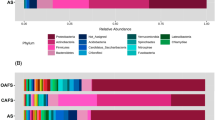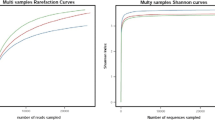Abstract
Tall fescue toxicosis and ergot alkaloids cost U.S. livestock producers approximately one billion dollars in annual livestock production loss annually. Ergovaline (EV) is the tall fescue alkaloid primarily responsible for clinical disease in livestock. Since native ruminal microorganisms have not been attributed to the detoxification of EV, finding detoxifying microbes from other environments is desirable. One possible source for potential microorganisms that can degrade EV is the anaerobic gut of the earthworm, Eisenia fetida. This study describes a comparative microbial analysis of earthworm digestive tracts receiving 10,000 ppb EV (E+ treatment) when compared with a control treatment with no detectable amounts of EV (E− treatment). An HPLC assay determined a 25% loss of EV from the E+ treatment was microbial in nature. A community microbiomic approach of constructing 16S-rRNA gene clone libraries was used to compare the microbes affected by the two treatments. RDPII tools such as Classifier and Libcompare were used in the analysis of 16S sequences. DOTUR analysis was used to examine the richness and diversity of the two microbial populations in these experiments. The results indicate there are few significant differences in the microbial community structure between the two microbiomes.



Similar content being viewed by others
References
Allison MJ, Mayberry WR, McSweeney CS, Stahl DA (1992) Synergistes jonesii: a rumen bacterium that degrades toxic pyridinediols. Syst Appl Microbiol 15:522–529
Bacon CW, Hill NS (1995) Symptomless grass endophytes: products of coevolutionary symbioses and their role in the ecological adaptions of infected grasses. In: Redlin SC, Carris LM (eds) Endophytic fungi in grasses and woody plants. American Phytopathological Society Press, St. Paul, pp 305–325
Benson DA, Karsch-Mizrachi I, Lipman DJ, Ostell J, Sayers EW (2008) GenBank. Nucleic Acids Res 36:25–30
Borneman J, Triplett EW (1997) Molecular microbial diversity in soils from eastern Amazonia: evidence for unusual microorganisms and microbial population shifts associated with deforestation. Appl Environ Microbiol 63:2647–2653
Cole JR, Chai B, Marsh TL, Farris RJ, Wang Q, Kulam SA, Chandra S, McGarrell DM, Schmidt TM, Garrity GM, Tiedje JM (2003) The Ribosomal Database Project (RDP-II): previewing a new autoaligner that allows regular updates and the new prokaryotic taxonomy. Nucleic Acids Res 31:442–443
Craig AM, Bilich DK, Hovermale JT, Welty RE (1994) Improved extraction and HPLC methods for ergovaline from plant material and rumen fluid. J Vet Diagn Invest 6:348–352
Davidson SK, Stahl DA (2006) Trasmission of nephridial bacteria of the earthworm Eisenia fetida. Appl Environ Microbiol 72:769–775
Dominguez-Bello MG, Lovera M, Rincon MT (1997) Characteristics of dihydroxypyridine-degrading activity in the rumen bacterium Synergistes jonesii. FEMS Ecol 23:361–365
Drummond AJ, Ashton B, Cheung M, Heled J, Kearse M, Moir R, Stones-Havas S, Thierer T, Wilson A (2007) Geneious v3.7, available from http://www.geneious.com/
Duringer JM, Lewis R, Kuehn L, Fleischmann T, Craig AM (2005) Growth and hepatic in vitro metabolism of ergotamine in mice divergently selected for response to endophyte toxicity. Xenobiotica 35:531–548
Engebrecht J, Brent R, Kaderbhai MA (2000) Alkaline lysis in 96 well microtiter dishes. Curr Protoc Mol Bio 15:1.6.2–1.6.3
Felenstein J (2004) PHYLIP (Phylogeny Inference Package) version 3.6. University of Washington, Seattle
Furlong MA, Singleton DR, Coleman DC, Whitman WB (2002) Molecular and culture-based analyses of prokaryotic communities from an agricultural soil and the burrows and casts of the earthworm Lumbricus rubellus. Appl Environ Microbiol 68:1265–1279
Humphries SS, Gwinn KD, Stewart AJ (2001) Effects of endophyte status on tall fescue tissues on the earthworm (Eisenia fetida). Environ Toxicol Chem 20:1346–1350
Jenkins MB, Franzluebbers AJ, Humayoun SB (2006) Assessing short-term responses of prokaryotic communities in bulk and rhizosphere soils to tall fescue endophyte infection. Plant Soil 289:309–320
Jones RJ, Megarrity RG (1986) Successful transfer of DHP degrading bacteria from Hawaiian goats to Australian ruminants to overcome the toxicity of Leuceana. Aust Vet J 63:259–262
Jurkevitch E, Minz D, Ramati B, Barel G (2000) Prey range characterization, ribotyping, and diversity of soil and rhizosphere Bdellovibrio spp. isolated on phytopathogenic bacteria. Appl Environ Microbiol 66:2365–2371
Karsten GR, Drake H (1995) Comparative assessment of the aerobic and anaerobic microfloras of earthworm guts and forest soils. Appl Environ Microbiol 61:1039–1044
Larson BT, Samford MD, Camden JM, Piper E, Kerley MS, Paterson JA, Turner JT (1995) Ergovaline binding and activation of D2 dopamine receptors in GH4ZR7 cells. J Anim Sci 73:1396–1400
Lodge-Ivey SL, Rappe MS, Johnston WH, Bohlken RE, Craig AM (2005) Molecular analysis of a consortium of ruminal microbes that detoxify pyrrolizidine alkaloids. Can J Microbiol 51:455–465
Panaccione DG, Johnson RD, Wang J, Young CA, Damrongkool P, Scott B, Schardl CL (2001) Elimination of ergovaline from a grass-Neotyphodium endophyte symbiosis by genetic modification of the endophyte. Proc Natl Acad Sci USA 98:12820–12825
Rattray RM, Craig AM (2007) Molecular characterization of sheep ruminal enrichments that detoxify pyrrolizidine alkaloids by denaturing gradient gel electrophoresis and cloning. Microb Ecol 54:264–275
Schloss PD, Handelsman J (2005) Introducing DOTUR, a computer program for defining operational taxonomic units and estimating species richness. Appl Environ Microbiol 71:1501–1506
Schnitzius JM, Hill NS, Thompson CS, Craig AM (2001) Semiquantitative determination of ergot alkaloids in seed, straw, and digesta samples using a competitive enzyme-linked immunosorbent assay. J Vet Diagn Invest 13:230–237
Schonholzer F, Hahn D, Zeyer J (1999) Origins and fate of fungi and bacteria in the gut of Lumbricus terrestris L. studied by image analysis. FEMS Microbiol Ecol 28:235–248
Sebat JL, Colwell FS, Crawford RL (2003) Metagenomic profiling: microarray analysis of an environmental genomic library. Appl Environ Microbiol 69:4927–4934
Wachenheim DE, Blythe LL, Craig AM (1992) Characterization of rumen bacterial pyrrolizidine alkaloid biotransformation in ruminants of various species. Vet Hum Toxicol 34:513–517
Weisburg WG, Barns SM, Pelletier DA, Lane DJ (1991) 16S ribosomal DNA amplification for phylogenetic study. J Bacteriol 173:697–703
Acknowledgments
This material is based upon research supported jointly funded by the Oregon Agricultural Experiment Station project ORE00871 and by the USDA, under Cooperative Agreement nos. 58-6227-8-044 and 58-1265-6-076. Any opinions, findings, conclusion, or recommendations expressed in this publication are those of the author(s) and do not necessarily reflect the view of the U.S. Department of Agriculture. The authors wish to thank Mr. Nevin Derstine for setting up the vermicomposters and Ms. Zelda Zimmerman for editorial assistance.
Author information
Authors and Affiliations
Corresponding author
Electronic supplementary material
Below is the link to the electronic supplementary material.
Rights and permissions
About this article
Cite this article
Rattray, R.M., Perumbakkam, S., Smith, F. et al. Microbiomic Comparison of the Intestine of the Earthworm Eisenia fetida Fed Ergovaline. Curr Microbiol 60, 229–235 (2010). https://doi.org/10.1007/s00284-009-9530-8
Received:
Accepted:
Published:
Issue Date:
DOI: https://doi.org/10.1007/s00284-009-9530-8




